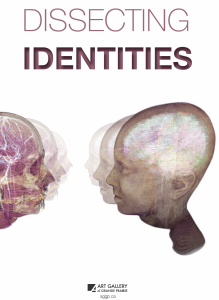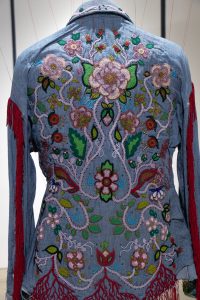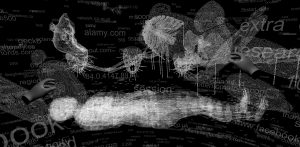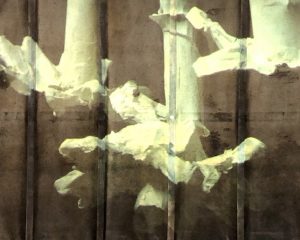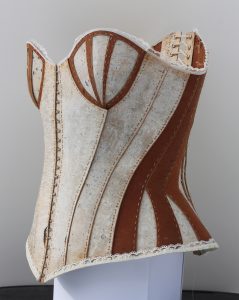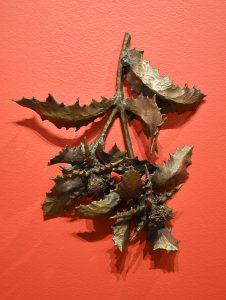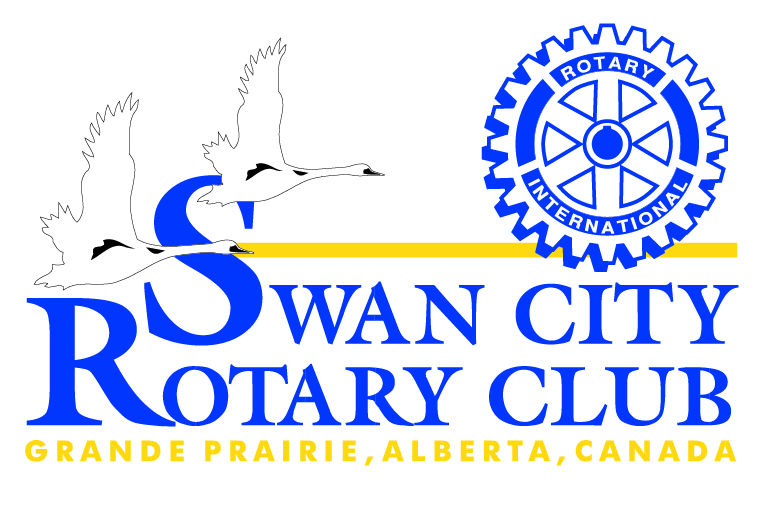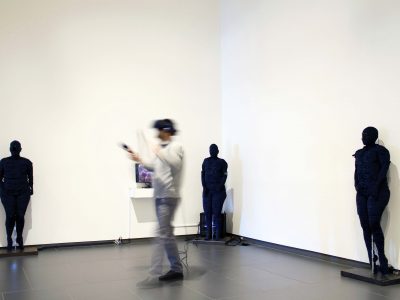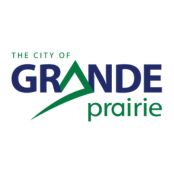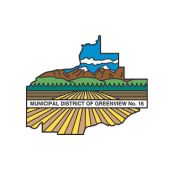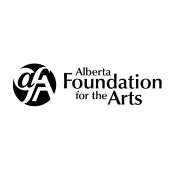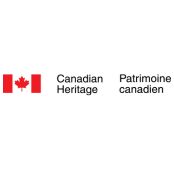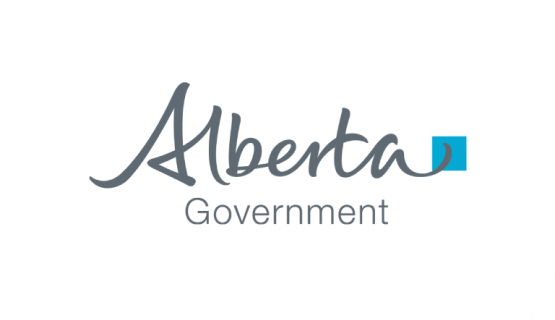Group Exhibition
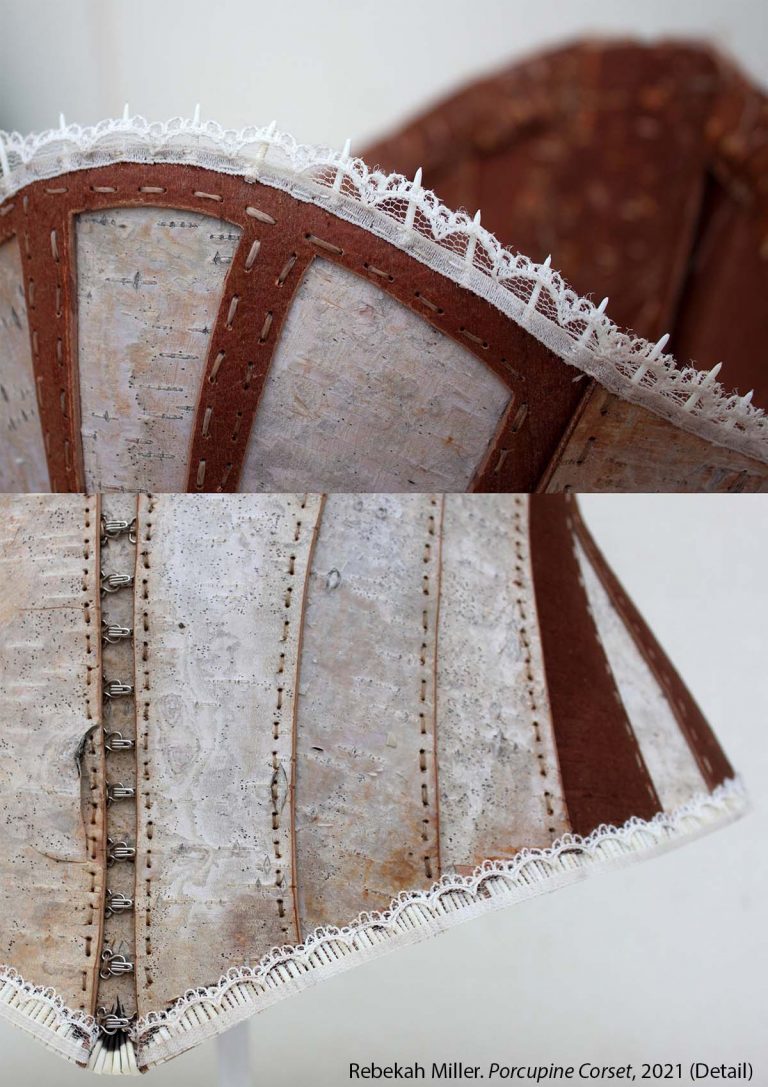
Dissecting Identities
Group Exhibition
February 10, 2022 - May 8, 2022
Curated by Manar Abo Touk, Curator, Exhibitions & Collections
Dissecting Identities features six artists from across Canada who work with a variety of mediums including painting, print, sculpture, new media, and Virtual Reality installations that examine the construction and deconstruction of identities in contemporary society. Through a demonstration of mixed mediums and artistic approaches that manipulate images, objects, and forms, the artworks explore themes that address the self and the blurring lines between digital, psychological, and physical spaces.
Entering the digital space through a combination of new technologies and printmaking, Marilène Oliver investigates digitized selves within the virtual world, overlapping realms of reality and virtual reality. Moving into the natural world, Paddy Lamb‘s installation engages with ideas around land, migration, and distorted memories. While the usage of natural materials presents different fragments of the self through installations by Rebekah Miller who examines the relationship between clothing and skin as a representation of one’s identity, and Haley Bassett who explores the loss of Métis identity through appropriation, commodification, and assimilation within society. Anna Williams uses sculpture as a social practice that addresses female identities and mental health, and paintings by Cara Guri investigate self-image as an extended object in portraiture. The artworks offer narratives that propose alternate realities that ask viewers to look within themselves and explore a deeper understanding on what constitutes their own identities.
Exploring themes around gender and identity, body and land, memory and place, the exhibition invites us to reflect on what defines each one of us and our relationships to the ever-changing world around us. Dissecting Identities aims to create space for reflection on how these topics impact us emotionally and physically, opening conversations around deconstructing our evolving identities within the natural and digital world.
Image Above: Rebekah Miller. Porcupine Corset, 2021. (Detail)
This exhibition is sponsored by: Swan City Rotary Club
Click image to enlarge.
Click the image to view Dissecting Identities exhibition catalogue
ABOUT THE ARTISTS
Cara Guri
ARTIST BIO
Cara Guri is a visual artist based in Vancouver, BC. She holds a Bachelor of Fine Arts from Emily Carr University and has completed a painting residency at Columbia University. She has received numerous awards for her work, including the Takao Tanabe Scholarship, the Brissenden Scholarship, and the Bishop’s Undergraduate Prize in Fine Arts. Her work has been exhibited in Canada and New York, NY. Recent exhibitions include The Reach Gallery Museum and Burrard Arts Foundation. She has also completed artist residencies with hcma, Burrard Arts and was an artist with Vancouver Mural Festival.
ARTIST STATEMENT
My current painting practice explores the relationship between identity construction and portraiture. My works examine the transactional nature of portraiture: the information that is given to the viewer and that which is withheld. Through my paintings I re-examine conventions and symbols that are found in historical Western figurative painting by translating them into my current reality in a way that disrupts their original meaning and intent. My paintings often place a barrier between the viewer and the subject, questioning viewership, the role of portraiture and the conventional dynamics of the gaze. I use the process of creating to observe, consider, decode, and recode the encounters that I have with both myself and the outside world, and to question what it means to see and be seen.
PROJECT DESCRIPTION
The exhibited paintings re-explore the role of portraiture while challenging the viewer to see the depicted subject in a new way. “Halo” and Sightlines” place a barrier between the subject and viewer to question the conventional dynamics of the gaze. The lamp and mirror blocking the subjects are typically devices used to highlight rather than conceal. The subjects retain a piece of their personal space and are not fully accessible to the viewer. “Three Graces” and “The Birth of Venus” were created by referencing paper still lives made from printouts of paintings from the canon of Western art. Prints of these paintings were cut up, crumpled, torn, distorted, and reconfigured into tableaus which were then used as references to create my paintings from. This series explores how meaning changes with time and translation, as well as complicating the visual representation of bodies that were originally depicted as idealized forms.
Cara Guri
Birth of Venus, 2018. Oil on panel, 16″ x 20″
Haley Bassett
ARTIST BIO
Haley Bassett is an interdisciplinary artist of Métis and Eastern European descent from Dawson Creek, BC. She was born in 1991 to cattle-rancher parents, and now lives and works in Sunset Prairie, BC. In May 2020, she completed her BFA in Visual Art from Emily Carr University. She received the BCAC Scholarship twice during her studies, and the Early Career Development Grant in 2020. Bassett started out as a painter; however, her practice has expanded to include sculpture, installation, found objects, natural materials, and beadwork. Her visual work explores how time, place, family histories and personal traumas converge as formational aspects of the self. Bassett founded the Northern Arts – Community Development Program in 2019, in partnership with the Dawson Creek Art Gallery. This program is designed to alleviate barriers to artistic professional development in northeastern BC.
PROJECT DESCRIPTION I
In Matrilineal, I have drawn inspiration from my Métis and Eastern European heritage to explore pathways to recovery from gender-based violence through often feminized artforms, such as Métis beadwork and matryoshka dolls. Through these mediums, I have conceptualized the self as a cultural identity that is held in sanctuary by one’s family, community, and Nation, which exists beyond the Western notion of the self as narrowly confined to an individual’s body, mind, and soul. Through beads, dolls, and roses, I have found my place within these traditions and identified a vital part of myself that is resistant to traumas or trials past and present. In this body of work, I have manifested my search for solace, resilience, and healing in the modes of expression wielded by my mothers and foremothers for generations.
PROJECT DESCRIPTION II
In Métis Modern I explore the nexus of indigeneity, assimilation, and survival, as well as the socioeconomic fallout of colonialism on the Métis diaspora, connecting the findings to the contemporary Métis experience through the archetype of the Hunter. The Hunter exemplifies the need to assimilate, or camouflage oneself to survive in Canadian society, as well as the ability to subvert colonial forces by practicing one’s culture in a socially acceptable way. Where once the Métis were called the Flower Beadwork People because their distinctive beadwork celebrated the flora around them, today the natural world manifests itself in the clothing of many Métis people through Realtree™ camouflage. These naturalistic Realtree™ designs are often accented with hunter orange, a colour used by hunters to identify themselves in the field. I intend to visually bridge the past and present by pairing modern hunting gear, Realtree™ camo and hunter orange with traditional beadwork.
Haley Bassett
Second Skin, 2021. Seed beads, thread, sculpting mesh, beading foundation, denim, copper and steel wire and Levi’s shirt
Marilène Oliver
ARTIST BIO
Marilène Oliver is an assistant professor of printmaking at the University of Alberta, Canada. Oliver studied fine art at Central Saint Martins and The Royal College of Art in London. Oliver has exhibited internationally in both private and public galleries including the Victoria and Albert Museum, The Wellcome Trust (UK), MassMoCA, Knoxville Museum of Art (USA) Frissarias Museum (Greece), Casino Luxembourg (Luxembourg), Fundació Sorigué (Spain) and The Glenbow Museum (Canada). Her work is held in a number of private collections around the world as well as a number of public collections such as The Wellcome Trust, Victoria and Albert Museum and Knoxville Museum of Art. Oliver currently leads two research projects at the University of Alberta: Dyscorpia: Future Intersections of the Body and Technology and Know Thyself as a Virtual Reality.
ARTIST STATEMENT
Marilène Oliver’s artistic practice sits at a crossroads somewhere between new digital technologies, traditional printmaking and sculpture, her finished works straddling the real and the virtual. Oliver uses various scanning technologies, such as magnetic resonance (MR) and computer tomography (CT) to reclaim the interior of the body and create art works that invite us to materially contemplate our increasingly digitized selves.
PROJECT DESCRIPTION
My Data Body
My Data Body is a collaborative, multimedia installation that include sculptures, video projection, prints and virtual reality. My Data Body brings together different forms of personal data such as medical scans, social media, biometric, banking and health data in an attempt to make visible and manipulable our many intersecting data corpuses so that in VR they can be held, inspected and dissected. In My Data Body, the medically scanned, passive, obedient, semi-transparent body becomes a data processing site that can be pulled apart, de- and re-composed or as Yuval Harari warns ‘surveilled under the skin’. My Data Body is an interdisciplinary and collaborative project made as part of the research project Know Thyself as a Virtual Reality (KTVR). Collaborators include Marilène Oliver (visual art), Scott Smallwood (sound), J.R Carpenter (poetry) and Stephan Moore (sound). My Data Body was made with the assistance of Daniel Evans, Kirtan Shah, Walter Ostrander, Chelsey Campbell, Jiayi Ye and benefitted greatly from the expertise of the whole KTVR research team
Tête-à-Tête
Tête-à-Tête is a VR artwork made using the MRI scanned head of the artist Marilène Oliver and an anonymized CT scanned head. The two scans are placed face to face, as if in an intimate and private conversation. Embedded into the CT scan is text from an automated brain analysis software called Freesurfer that logs the skull stripping, brain segmentation and quantification of Oliver’s brain. In Oliver’s brain scan is the 3D model generated by Freesurfer of the segmented brain. The brain segments are displayed as meshes and that emit keywords that relate to different functional areas in the brain. Multiple aspects of the VR environment can be interacted with, allowing both heads to be dissected and inspected. Tête-à-Tête seeks to depict and reflect upon the growing use of automated software to read and processing brain scan data. As such the intimate conversation between the anonymized CT scan (which signifies anonymized data and automation) and the artist (which signifies the human generating data) is a metaphor for the rapidly evolving relationship between human and artificial intelligence.
Marilène Oliver
Decomposed, 2021. Laser engraved metallic spray paint on BFK Rives
Paddy Lamb
ARTIST BIO
Paddy Lamb is an Irish born Canadian whose descendants include Ulster-Scots, Quaker, Huguenot, Celtic, and Proto-Indo-Europeans. Born in the city of Armagh, Northern Ireland, he studied Modern History at Trinity College, Dublin, and Physical Education and History as a post-graduate at the University of Alberta. He moved to Canada in 1985 and subsequently worked as a historian and archivist before devoting himself to a full-time career as a visual artist.
For more than two decades his work has focused on an interpretation of the physical and social landscape in the form of drawing, painting and installation. It is strongly influenced by history, memory and social culture, offering a personal narrative concerning human migration and attachment to the land.
Paddy is the recipient of several scholarships and awards from the City of Edmonton and the Province of Alberta. In 2009 and 2011 he received a fellowship and residency at the Ballinglen Arts Foundation in Ballycastle, Co. Mayo. He has also been awarded residencies at the Thomas Gushul Studio in Blairmore, Alberta, The Ortona Armoury in Edmonton and 2 Rooms Contemporary Art Projects in Newfoundland. Paddy is a past-president of CARFAC Alberta. He is currently National President and Spokesperson for CARFAC.
ARTIST STATEMENT
“Landscape’ is not backdrop or wallpaper, it’s a medium, teeming with opportunity and volatile in its textures.” [1]
Rather than confining a definition of landscape to the sensations that accompany the first encounter, I am more interested in what Robert Macfarlane, so aptly describes as landscapes which are “withdrawn from actuality” but inhabited by memories to which we form deep and lasting attachments. My work attempts to explore the imprint of society on nature in a variety of ways.
By inhabiting a space and documenting the physical impact of society on the environment, I am trying to illustrate the shifting balance between man and nature. It is an investigation of how that impression persists and diminishes through different waves of migration and activity, endurance, and memory. While this inventory of work often uses repeated visits to a specific piece of land as its bedrock, it also gives consideration to the patterns and value systems we create and impose on the environment. Contemporary issues are included, notably, a reaction to society’s current tendency to treat objects and ideas as consumables as part of an overarching search for the new.
More recently this has led to an interest in aspects of abandonment, neglect, and disuse as part of the physical landscape. As a consequence, the flawed and the incomplete often become more meaningful than the ‘ideal’ alternative. These reminders of human attachment become the initial subject matter for paintings and drawings. Their original purpose is generally consumed by the studio process through documentation, dismantling, and reuse of collected ideas and imagery. Tested by time and imprinted in memory, objects and artifacts develop a deeply personal, tactile significance; one that reflects on different eras of cultural heritage, and also challenges any limited definition of commemoration or monument.
My aim is to recreate different aspects of the human landscape, but also to create new and personal ways of representing the rich interface between past, present, and future. The land is such a vital repository for our history, culture, and collective memory. It is also a gateway to a form of self-examination; a search for alternatives that continues to define my own ‘sense of place’ but still represent our lives and everything we know.
PROJECT DESCRIPTION
The idea for this work grew out of some experiments combining drawings with three dimensional objects at a residency. These attempts became quite physical – a realization that, in this case, drawing alone seemed inadequate.
The white pulp paper sculptures are modelled from the remnants of a metal spindle used to rotate threshing wheels. The canvas binder also belonged to an old thresher-binder machine. The shapes and materials struck me as deeply organic as well as manufactured. I was also pleased to be able to reuse found materials – something that is of increasing importance in my practice.
The potential for the use of sculpture, light, shadow, and video developed in the studio and during installations. I was attracted to the slow, unpredictable, independent movement of the mobile sculptures – as if there was a conversation taking place or a dance in slow motion. Where does this begin; in the mobiles, in the shadows, or with the white shapes that appear both real and ephemeral on the unfurled binder panel? They echo back and forth, distorted, like our memories.
I have always been interested in landscapes which are “withdrawn from actuality” but inhabited by memories to which we form deep and lasting attachments. My work attempts to explore the imprint of society on nature in a variety of ways. Several writers, notably Robert MacFarlane and Maria Stepanova, have articulated this very well. They ask significant questions about the traditional notion of history, memory, and monument, particularly the recent tendency to project our own desires, weaknesses, and passions on the past without any opposition – the past cannot speak.
“The landscape of memory is strewn with projections, fantasies and misinterpretations – the ghosts of today, with their faces turned to the past.” [2]
The accepted definition of monument has always seemed troublesome. This has reinforced my belief that a rusted piece of machinery, a collection of rocks, a dilapidated shed, a beaten path, or a weathered bone can speak more directly about the past precisely because they are not manipulated by our current preoccupations.
Or perhaps the past does not need so immediate an explanation. Rather, creativity and imagination remain a gateway to a form of self-examination; a search for alternatives that continues to define my own ‘sense of place’ but still represent our lives and everything we know.
Paddy Lamb
Reaper: Binder: Reinventor
Canvas panel, pulp paper, acrylic, video
Varies with installation. Panel: 38 x 180 inches
[1] Robert Macfarlane, Landmarks, Hamish Hamilton 2015, p.315
[2] Stepanova, Maria. In Memory of Memory p.87
Rebekah Miller
ARTIST BIO
Rebekah Miller is a visual artist working in various mediums including: drawing, sculpture, printmaking, textiles and photography. She completed her BFA at Alberta College of Art and Design in 2008 and her MFA at the San Francisco Art Institute in 2011.
Rebekah’s art practice largely revolves around human interactions with nature, in addition to rural Canadian homesteading and hunting practices. She is interested in examining lifestyles of our collective past and applying this knowledge to her own life as well as expressing her findings and experiences through her studio practice. Rebekah lives and works in Dawson City, Yukon.
ARTIST STATEMENT
Skins
Within our clothing, we find our identities, ourselves and to some extent our homes. We inhabit our clothing as we do our skins. The notion of the skin as a form of clothing – a covering, as well as a primary indicator of the form in question – is a central concept within my practice.
Created through the act of skinning and gathering bark from birch trees, the corset is a vessel as well as an entry point into the elemental home, itself forming the matrix of our relationship to the natural world. It is through this process that I intend the viewer to gain a deeper understanding of our relationship to nature through the metaphoric inhabitation of this skin as well as to transport the viewer back into a landscape outside of modern culture – to a habitation more heavily rooted in the subliminal but also anchored in basic practices such as hunting, gathering, building, and dwelling.
Within this work, I want to convey a sense of desire to return to this lost place through an idealized notion of the past while paradoxically denying the viewers entrance through the works materiality of the skin actualized. It is this tension between what is represented through the exterior physical barrier of the subject and the perceived interior space for reception which intrigues me most. Presenting itself as a mere husk of the original, the corset is characterized by its inherent inability to produce the substantiated figure. Through my work with the corset, I attempt to provide evidence of the forms and places in question rather than to represent their presence in full. What remains is a whisper of their former selves, eulogized through the delineation of skin.
PROJECT DESCRIPTION
Birch Corset and Porcupine Corset were made using primarily the bark of the tree to achieve both their formal and aesthetic attributes. These works were an enormously difficult challenge for me because never had I been involved in garment construction or using the material in this way.
The process had a number of stages. First, I harvested birch trees for their bark during late fall and the early winter months when the resin beneath the bark was less likely to cause the skin to curl once removed. Then, the trees were brought into a warm space where they thawed and became more pliable. After I removed the bark in lengths as long as I could manage, I stacked them on top of one another and flattened them under a heavy weight. Then, I soaked the bark until it became soft before cutting my pattern to be sewn in sequence. Finally, I became heavily involved with design, ornamentation, and presentation.
This entire process includes a myriad of labour practices which I associate with homesteading including the clearing of land, gathering of materials, building of architecture (the architecture of the corset) as well as textile practice. All these things have relevance for me.
It is through my own experiences of homesteading that I have been able to develop further insight into the life and history of my own ancestors. Creating the corset is a way for me to figuratively embody its skin and to understand modes of living that have largely been lost.
Rebekah Miller
Porcupine Corset, 2021
Birch bark, porcupine quills, sinew, hardware, lace.
Anna Williams
ARTIST BIO
Anna Williams was born in Ottawa, ON. After studying sculpture and printmaking at Mount Allison University in Sackville, NB, she returned to Ottawa where she continues to work, live, and garden with her wife, children, dogs and an excessive number of houseplants. Her artwork employs the animal and narrative to examine the construction and manipulation of female identity and power relationships in contemporary society. Through an exploration of poetry, drawing, print, sculpture and installation, Williams articulates her struggles with mental health, self-image, and identity.
Williams has had solo shows in both Canada and the U.S. and had works purchased by the Canada Council Art Bank, the Government of Canada (Embassy of Belgium and Luxemburg), Ottawa Art Gallery, City of Ottawa, and Humber College as well as numerous national and international private collections. In addition to being, Assistant Dominion Sculptor for the Government of Canada creating the sculptural and decorative programs for parliament, Williams has also created public works in Ottawa, Toronto, and Montreal.
ARTIST STATEMENT
In my practice I reflect on what we have lost in our passage from nature to culture – our skewed experience of the natural world and female identity, and how this dissociation has impacted our sense of belonging and inclusion. Through print, sculpture, and installation, I investigate how family history, identity, and mythologies of womanhood can intersect to offer alternative definitions of what it means to be female, and the importance of re-establishing a partnership with the natural world as a means to claim our intersectionality.
For women and nature alike, physical, and psychological borders define our reality. The borders between feminine and unfeminine, human, and animal, tameness and wildness, savage and civilized – rules about what is natural and what isn’t – govern women’s lives. As a woman I have struggled and failed to fit traditional definitions of femininity – too male to be female and too female to be male. In my practice, I engage with what is considered appropriate female behaviour as I explore female identities, and the impact this struggle has on my own mental health.
Although we are the descendants of ancient Greece intellectually, politically, and artistically, the philosophy of man as the centre of the universe, created in the image of the gods, has had catastrophic consequences for both women and the natural world. Together women and nature found themselves on the wrong side of a binary existence and have become allies in Otherness.
I’ve come to a place where the need for alternative definitions to the binary expectations of womanhood has become an imperative. Definitions into which I, a queer female artist and mother, fit –more importantly, ones where in order to fit I do not have to practice the ritual excision and sacrifice of those parts of myself deemed unacceptable and incongruous. As my role of wife and mother take over more of my identity, it is becoming increasingly impossible to integrate myself and my family into society’s assumed heteronormative definitions of those identities.
We are the stories we tell ourselves. The primary goal of my practice is to offer narratives to support and nourish those women on the margins who seek an ally. I aim to reclaim, reframe and shift entrenched societal narratives in order to challenge what is considered acceptable female behaviour. I want to encourage a sense of belonging, expand circles of trust, and foster a notion of the collective that offers inclusion as the standard instead of integration. With the intention, that women like myself, who have never felt like they belong, can move between borders and begin to see ourselves reflected in the culture that surrounds us.
PROJECT DESCRIPTION
Remedy
Remedy consists of 16 cast bronze medicinal plants historically used to treat “female disorders” and mental illness, hanging in a grid reminiscent of an apothecary display. This piece seeks to remind viewers how the natural world and the nuances of the female body so often find themselves ordered and pushed into the Linnaean System of Classification and hierarchy, becoming medicalized through the process as they are stripped of their wildness and power.
In this work, the historical narrative of the material and the flora being represented come into conflict. Throughout history bronze was viewed as a masculine, technically challenging, and highly valued material and was therefore elevated as a status symbol of the patriarchy through excellence, wealth, and power. In creating and reclaiming those elements of the natural world used to cage, classify, weaken, and shame women’s bodies and psyches within a patriarchal society in bronze, I am bringing together what was viewed as base, animal, and mystic, and monumentalizing it as valued, strong, and immutable. Through the act of laying bare and challenging the notion of the monument, I offer a reclamation of acceptance and strength while reframing what is classified as female vulnerability.
Anna Williams
Remedy: treatments for female disorders and mental illness
Edition of 1, 2017
16 Cast Bronze botanicals, 14” x 16” x 6” each


